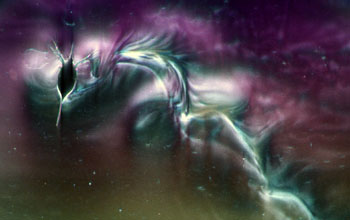Multimedia Gallery
"Footprints in Water"
"Footprints in Water."
This image shows small water creatures (Daphnia lumholtzi), 1.5 millimeters in length, that create relatively large disturbances in their surrounding water. Each animal swims somewhat differently, and, being of different sizes and shapes, creates species-specific disturbances similar to terrestrial animals moving in snow. Optical techniques allow visualization of these "footprints." The creatures use these footprints to distinguish between predators, prey and mates.
The Daphnia seen here moved from the left lower edge to the center of the picture, filtered a volume of water there in search of food, then changed position to start filtering a new volume of water. The image was taken during research by Professor J. Rudi Strickler, currently of the University of Wisconsin-Milwaukee (UWM). To learn more about Strickler's research with these tiny water creatures, see the UWM Research Profile article, "The Mating Game".
This graphic was an entry in the 2005 Science & Engineering Visualization Challenge competition, sponsored by the National Science Foundation and the journal Science. The competition is held each year to recognize outstanding achievements by scientists, engineers, visualization specialists and artists who are innovators in using visual media to promote the understanding of research results and scientific phenomena. To learn more about the competition and view all the winning entries, see the Science & Engineering Visualization Challenge Special Report. (Date of Image: May 2005)
Credit: Photo by J. Rudi Strickler, University of Wisconsin-Milwaukee
See other images like this on your iPhone or iPad download NSF Science Zone on the Apple App Store.
Images and other media in the National Science Foundation Multimedia Gallery are available for use in print and electronic material by NSF employees, members of the media, university staff, teachers and the general public. All media in the gallery are intended for personal, educational and nonprofit/non-commercial use only.
Images credited to the National Science Foundation, a federal agency, are in the public domain. The images were created by employees of the United States Government as part of their official duties or prepared by contractors as "works for hire" for NSF. You may freely use NSF-credited images and, at your discretion, credit NSF with a "Courtesy: National Science Foundation" notation.
Additional information about general usage can be found in Conditions.
Also Available:
Download the high-resolution JPG version of the image. (1.1 MB)
Use your mouse to right-click (Mac users may need to Ctrl-click) the link above and choose the option that will save the file or target to your computer.



